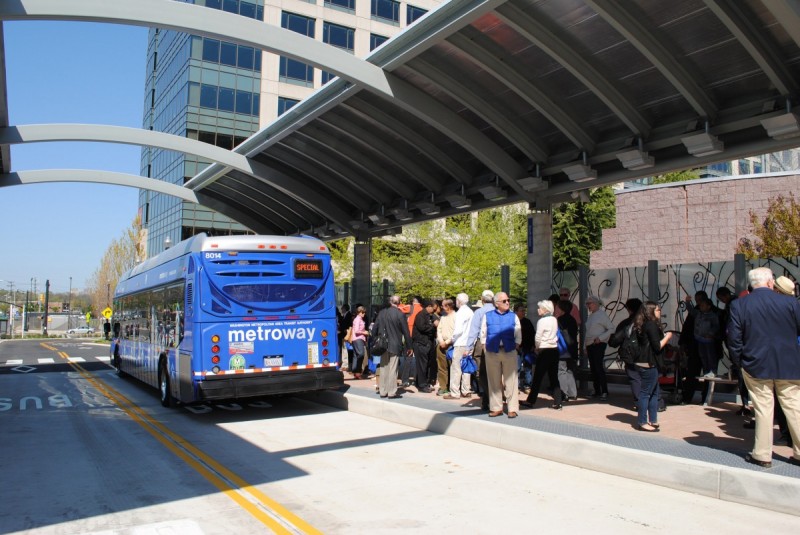Top posts of 2018: Here are 5 new infrastructure projects we’ll likely get with Amazon

Image showing potential project sites from Northern Virginia's incentive package transportation presentation.
This article was GGWash’s 8th most popular post in 2018. If you like what you read, please support our journalism by joining the GGWash Neighborhood, our membership program. You contribution keeps our blog going, and also connect you to our community of readers. Join today!
Amazon's HQ21/2 is coming to Crystal City, Pentagon City, and Potomac Yard, an area that local officials dubbed “National Landing” to avoid writing out three neighborhood names over and over again. Amazon’s arrival will mean at least $195 million in new transportation infrastructure from Virginia, on top of the $570 million it was already planning on investing into the area.
If Amazon exceeds the 25,000 job benchmark, the state will make up to another $100 million in transportation money available. Here’s what’s planned for the new money:
Current Crystal City Metro entrance by Antony-22 licensed under Creative Commons.
1. A second entrance to the Crystal City Metro
The Crystal City Metro would get a new entrance, including both elevators and escalators at the northwest corner of 18th St S and Crystal Drive, right across from the Mount Vernon Trail entrance and below 1770 Crystal Drive, an office tower Amazon has leased. This long-planned project would improve access to the station from points East, particularly the Metroway Bus Rapid Transit (BRT) system and the planned Crystal City Virginia Railway Express station. Until the Amazon deal, it did not have construction money, but space for it was reserved within the Crystal City Central District Retail overhaul just approved by the county board.
Rendering of the Potomac Yard Metro station. Image by City of Alexandria. 
2. The originally-planned South Entrance to the Potomac Yard Metro
When construction bids came in well over budget for the new Potomac Yard Metro Station, officials decided to cut its entire southern entrance, significantly reducing ease of access to the station for many homes and businesses and sparking an outcry. This funding would build that Southern entrance after all. It's unclear at this time whether construction would be able to occur simultaneously, or whether the southern entrance would be added later.
Ribbon cutting for the Crystal City Potomac Yard Transitway by Arlington Department of Environmental Services licensed under Creative Commons.
3. Improvements to the Crystal City-Potomac Yard Transitway
The Metroway BRT line currently connects Crystal City, Potomac Yard, and parts of Northern Alexandria. Some of the line runs in dedicated bus lanes, while other portions operate on normal roadways mixed with cars. With the new money, the dedicated lanes would be extended to Pentagon City via 12th Street South, and a portion of the line in Potomac Yard which currently operates in mixed traffic would be re-routed into new sections of transitway. The Pentagon City extension is being funded by an existing state grant, so it is likely that the new money is exclusively for the Potomac Yard improvements.
Mockup of what the pedestrian bridge project could look like. Image by CC2DCA used with permission. 
4. A pedestrian bridge between Crystal City and National Airport
This pedestrian bridge (or it could potentially be a tunnel) across the George Washington Memorial Parkway and CSX railroad tracks from the airport to Crystal Drive would make Crystal City a simple, easy-to-follow, three-minute walk from National Airport. A recent analysis shows that it would put 3,600 hotel rooms, 11 million square feet of office space, and 5,700 homes within a 15-minute walk of the airport. Prior to the deal, Arlington had provided enough money to start—but not complete—the environmental permitting process, but hadn't identified a source of funds for construction or engineering.
View north along US Route 1 by Famartian licensed under Creative Commons._from_Virginia_State_Route_233_(Airport_Viaduct)_in_Crystal_City,_Arlington_County,_Virginia__800_600_90.jpg)
5. Converting Route 1 into an urban boulevard
One of the most ambitious transportation items in the Crystal City Sector plan (other than the now-cancelled streetcar) was a vision for converting Route 1 from an urban highway to an urban boulevard. The Amazon bid proposes providing a bit more than half of the expected $250 million required to do so. This massive engineering project would move existing off ramps to the center of Route 1, allowing new buildings to front onto the street. It would simplify the complicated traffic signals currently in use and add wide sidewalks and street trees.
